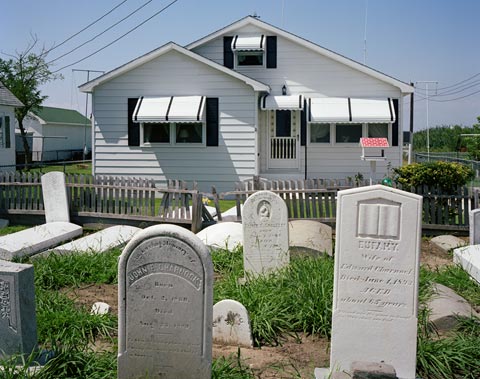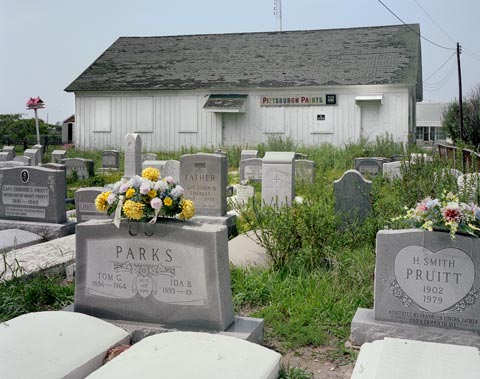
Tangier Island, Chesapeake Bay, Virginia, 1984 (4×5 film)
Is Photography Dead? Peter Plagens in a Newsweek article makes a mess of the recent explosion of photography in the museum/gallery scene and the concomitant use of Photoshop to create seamless fictional realities.
Here’s the key paragraph from his article:
Yet wandering the galleries of these two shows (the Met and National Gallery), you can’t help but wonder if the entire medium hasn’t fractured itself beyond all recognition. Sculpture did the same thing a while back, so that now “sculpture” can indicate a hole in the ground as readily as a bronze statue. Digitalization has made much of art photography’s vast variety possible. But it’s also a major reason that, 25 years after the technology exploded what photography could do and be, the medium seems to have lost its soul. Film photography’s artistic cachet was always that no matter how much darkroom fiddling someone added to a photograph, the picture was, at its core, a record of something real that occurred in front of the camera. A digital photograph, on the other hand, can be a Photoshop fairy tale, containing only a tiny trace of a small fragment of reality. By now, we’ve witnessed all the magical morphing and seen all the clever tricks that have turned so many photographers—formerly bearers of truth—into conjurers of fiction. It’s hard to say “gee whiz” anymore.
First of all, there have always been photographers who used the medium to create alternate realities, or who sought to make photography more art-like by using different techniques, materials, or color palettes, and, of course, those who mixed media to create hybrid objects that were not easily classifiable. Indeed, it has long been understood that photography’s relationship with reality, while rooted in it, is tenuous. Even a photographer like Cartier-Bresson considered himself, ultimately, a surrealist despite being the epitome of a “straight photographer.” As the Richard Lacayo wrote in Time earlier this year:
We connect Cartier-Bresson to photojournalism because he founded the news photo agency Magnum. But he was trained first as a painter. And when he started to take pictures in the early 1930s he wasn’t interested in gathering news. He was a newly hatched surrealist on the hunt for miracles, moments when the real world somehow gave you a fleeting glimpse of the uncanny.
I recall the John Szarkowski curated show at the Modern in 1978 (just after I arrived in New York) called Mirrors and Windows, which posited two main paths in photography, the one seeing out into the world through a frame, the other reflecting the inner world of the photographer. This dialectic made for a contentious exhibition–which side of the great divide do you live on? Obviously, there was and is no clear divide between inside and outside, although there is no doubt that photographers and artist have different intentions with regard to depicting the inner and outer world. Those intentions are still at the heart of the matter, and the introduction of Photoshop has not changed things one bit.
Robert Hughes, back then, wrote in Time about Mirrors and Windows:
The most striking thing illustrated by the show is how far behind photography—meaning the photographs Szarkowski designates as “serious”—has left its old role as witness to public events. …Wars, elections, riots, disasters, communal ecstasies, the speeches of politicians and their deaths—all are eaten up by the omnivorous lens, as photography (through journalism) defines the terms of our fictitious intimacy with the world.
So in 1978 Hughes talked about photography and the “fictitious intimacy” with the world, and now almost 30 years later Plagens refers to photographers as former bearers of truth turned into “conjurers of fiction.” Plagens goes on to suggest that the turning point in this move away from realism was the work of Cindy Sherman, specifically her movie stills series, which quoted a photographic genre expressive of verisimilitude as opposed to unmediated reality. As actual photographs, however, they are documents of a performance–her dressing up and posing in carefully chosen locales–and have nothing to do with a Photoshop created reality. While they were groundbreaking pictures conceptually, they were, otherwise, conventionally made.

Tangier Island, the Chesapeake Bay, Virginia, 1984 (4×5 film)
For a while it appeared that postmodernism, which Cindy Sherman is linked with, declared every creative endeavor dead on arrival. How could one write a conventional story, make a painting, or compose music as authentic expressions of observation or self-reflection once we knew that such attempts were exercises in futility like trying to nail jello to a wall?
Well, we stared down that abyss and moved on with a myriad of different strategies (fractured beyond all recognition) in spite of the eschatological pronouncements of the high priests of art criticism. I will have more to say about all this, perhaps, unless the now useless task of making photographs gets in the way. Stay tuned.